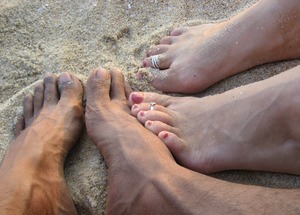Foot Reflexology – a therapeutic form of foot massage – is an alternative healing technique that has been used for centuries. Early man, walking barefoot over the open countryside, was enjoying the benefits of reflexology without even realizing it. Both the ancient Chinese and Egyptian cultures valued the healing effects of foot reflexology on the entire body.
Not until the early twentieth century did reflexology reach the West; and its benefits are largely lost on us, a society that values sharp clothes and tight little shoes.
What Is Reflexology?
Jamming your toes into tight shoes – especially dress shoes – actually restricts blood circulation to muscles and nerves. Reflexologists work to correct this imbalance, believing that specific areas on the feet reflect all of the body’s internal organs and systems. When pressure is applied to specific points on the feet, dissolving deposits of uric acid crystals that have settled in the feet, the body is stimulated from the inside out.
Each of the specific points are called reflex zones. Systematic pressure to these zones increases circulation of blood and nerve supply to your body, triggering a natural healing process.
Reflexologists might identify places in the foot that are sensitive to pressure or note skin changes to determine what is causing health problems. They can also work with a person who knows they have a specific health problem – a pinched sciatic nerve, for example – and concentrate on the reflex zones that are related to that problem.
In general, the form of therapy is used to aid people suffering from fatigue, circulatory disturbances, headaches, backaches, and menstrual complaints. Used in combination with an herbal diuretic, it also helps remove toxins from the body and restores a proper fluid balance in the body’s tissues.
Applying Reflexology at Home
You don’t have to be a reflexologist to enjoy the benefits of this therapeutic massage. While having two hands and at least a few fingers is definitely a bonus, you don’t even need that.
The most basic form of reflexology you can do at home would be to use a foot roller. These ergonomically designed wooden rollers are available in many specialty stores, and actually mimic the hands-on action of a reflexologist. They are available in hand-held forms, as well as small little platforms that you actually stand on and roll under your feet.
Hand-held foot rollers are pretty easy to use. Just slip off your shoes, and massage pressure points on the bottom of each foot to stimulate circulation. Either method – the hand-held roller or the kind you stand on – should be used every day for about ten minutes at a time to relieve tension, increase your energy levels and enhance feelings of well-being.
As long as you have a pair of hands and at least a pair of thumbs, though, there’s no reason to go out buying tools. You can easily perform reflexology using this method:
Slowly exert pressure on reflex zones (if you scroll to the bottom of this page, there is a great chart for both foot reflexology and hand reflexology). Continue adding pressure until just before you start to feel discomfort. Then, release the pressure just slightly. The actual amount of pressure you’ll need to use will vary between reflex zones and your own sensitivity.
The benefits of reflexology can be felt almost immediately. A warmth in the stimulated area is a sign of increased circulation, which is the beginning of the self-healing process.
After a reflexology session, gently apply lotion or essential oil to your feet. Using a massage oil that contains rosemary or lavender will aid relaxation, while an oil that contains mint is seriously rejuvenating.



